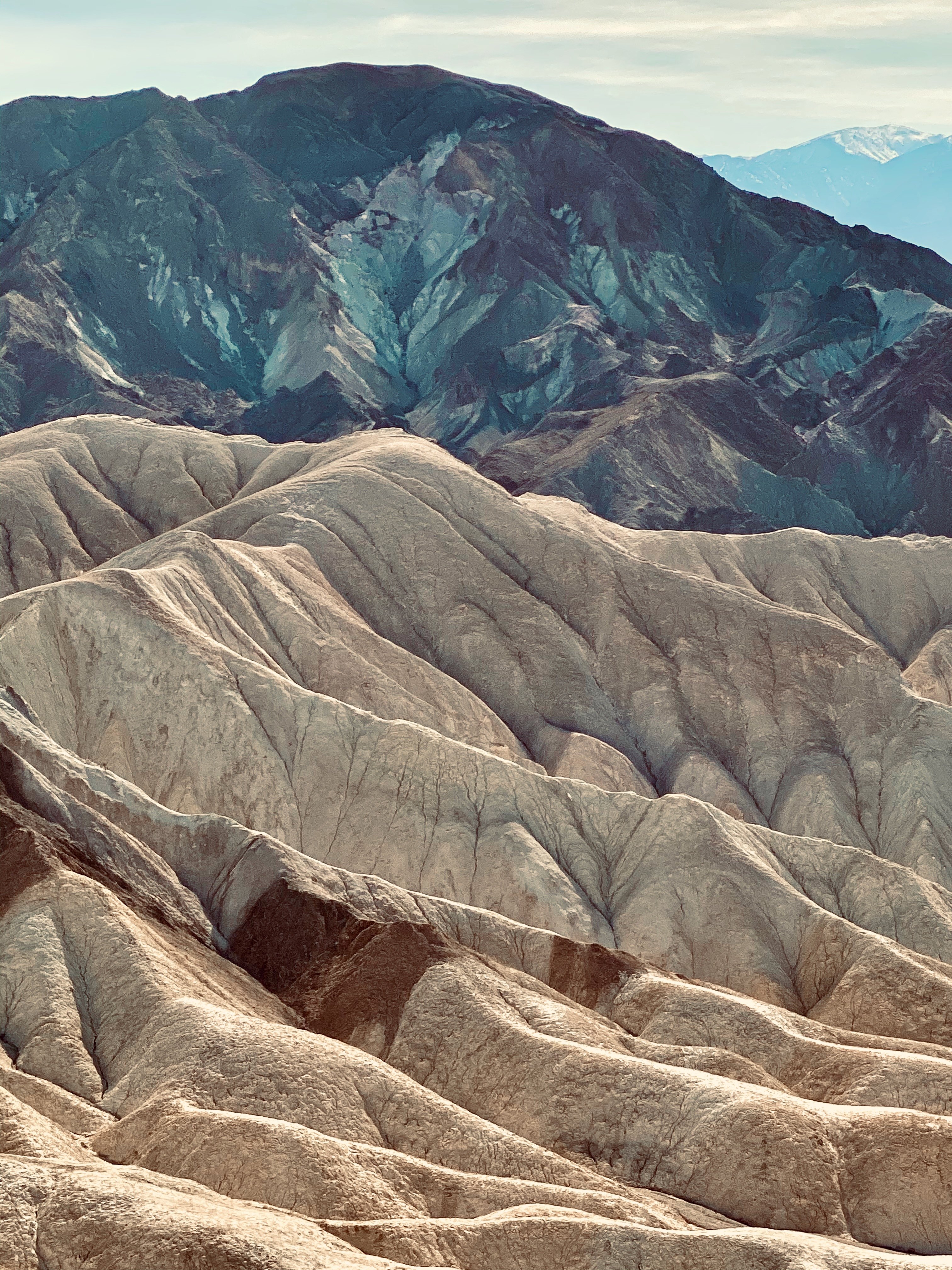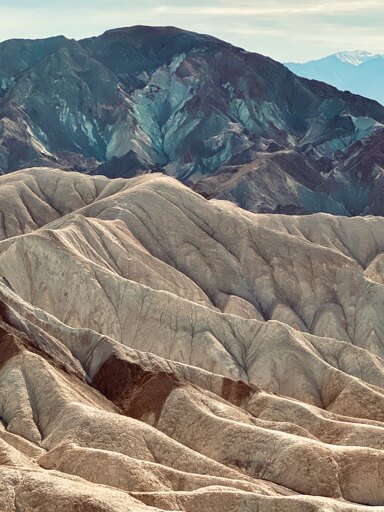

Zabriskie Point, Death Valley National Park. Photo: Jeffrey St. Clair.
Doomscrolling, an addictive habit, can be destructive if not managed – the way an alcoholic, say, manages drinking herself to death. It must be done with care, with binges considered for the long haul. “Overindulging…may be detrimental to your mental health,” warns the doomscrolling subreddit r/Collapse. “Anxiety and depression are common reactions when studying collapse…If you are considering suicide….” (If you are considering suicide: this may end up one of the mantras of the era of modern civilizational crack-up.)
“Maybe typing the whole thing out will be therapeutic,” writes an r/Collapse commenter in a post titled How I think the future will play out, which he/she intended as a prediction of events unfolding in the worst of all possible futures. It was one of the doomiest posts I found in months hanging around r/Collapse. I reproduce it here only slightly edited and with its lousy grammar intact.
First off, writes the doomer, “There will be crop failures which will get worse and worse, food prices will soar….Because of crop failures and water shortages, there will be more mass migrations, which will make the 2010s migrations look tame. It’ll be like the Syrian refugee crisis but MUCH worse.”
“But, the world hasn’t ended yet, we’re still in the 2020s…Wars over resources, rise of nationalism, rampant polarization, rampant criminality, martial law, civil wars, the loss of basic human rights…I guess you could say that society [is] in a state of crisis.”
The writer offers a funeral oration for each of the decades to come. “If society doesn’t collapse in the 2030s, the surviving nations will be horrible places to live and are barely getting by or rather slowly rotting from the inside and out, failed nations will be warzones and the people who still live there (those who have not migrated) would live a life similar to Mad Max.”
By the 2040s, “If any civilization still exists in the north it is hanging on by a thread. Feedback loops like hot oceans, burning forests, rotting soil [huh? – ed’s note], thawing permafrost and others are increasing temperatures at an increasingly fast rate, the situation is like a rock rolling off the cliff but now it is falling and nothing can be done to stop it.”
By the 2050s, “best case scenario there could be a few hundred million people in total left living in the tip of south america and in the arctic north. But as time goes on, many if not all will die of starvation and violence.”
By the 2070s, my teen-aged daughter will be in her mid-60s. I am told at r/Collapse that by then she will be reduced to a dispersed ash in Plasticene soil. “The oceans are boiling, the air is toxic and unbreathable…It is now too hot for humans to survive, there is no food left…no fresh water to sustain you…There will be nothing left of us…we will all become part of the layers of plastic and everything else compressed into the dirt…For the price of apathy, inertia, and carelessness, hell will ultimately be realized.”
The stuff of apocalyptic prophecy, a wiping clean of the slate, the end of all humanity, but a tale that doesn’t have the benefit of Revelation, because in the end there will be no redemption.
The writer talks about “typing the whole thing out” as a form of soothing. Collapsitarian culture is an outpouring of grief, an expression of existential distress over ecological disorder. Psychologists have come up with a term for this type of grief: solastalgia, a mourning for the perceived disappearance of the “normal,” “stable,” “healthy” natural world. The precise definition is “the distress that is produced by environmental change impacting on people while they are directly connected to their home environment.” Nostalgia we know well: it is the pain when we are away from the familiar, uprooted from home ground. Solastalgia is the pain when home collapses around us, home being all earth, a total falling apart the thing we most fear.
It may be that solastalgia, a hypersensitivity to the threat of collapse of the only home we know or will ever know, is a necessary condition for humanity’s longterm survival. Collapsitarians are ahead of the curve in feeling deeply the pain of ecological crisis and seeing with not entirely clear eyes, but with eyes wide enough, the existential nature of the crisis. If the most extreme among them sound like mad prophets, then we who deny the seriousness of the crisis, who think everything’s going to be alright by our embrace of an unfounded optimism, are the deceivers.
From the actual scientists on the doomscroll (as opposed to the prognosticators in the desert of Mad Max), one gets the sense that the end – an end – of business-as-usual is built into our current trajectory. The late Will Steffen, who was one of Australia’s top climate scientists until his death in 2023, at age 75, remarked that as industrial society has already passed 9 of 15 Earth system tipping points, this could set into a motion a process at the end of which “collapse of civilization is the most likely outcome.”
Have a look at a small sample of the scroll for the months of October and November. Australian oceans face an “uncharted future,” two of three corals in its world-heritage listed Ningaloo reef now dead, while the country’s possums show some of the highest levels of PFAS chemicals to be found in small mammals. Two iconic coral species off the Florida coast were discovered to be “functionally extinct,” as the planet’s first “catastrophic climate tipping point” has been reached as coral reefs across the oceans suffer “widespread dieback.” A third of British farmers made no profit in the past year, facing “extreme floods and droughts that have led to some of the worst harvests on record.” There were deadly floods in Mexico, Nepal and Vietnam, where 100,000 people were driven from their homes. Overarching all this, carbon emissions from fossil fuels in 2025 hit a record high. Scientists writing in the journal BioScience report “We are hurtling toward climate chaos. The planet’s vital signs are flashing red….This unfolding emergency stems from failed foresight, political inaction, unsustainable economic systems, and misinformation. Almost every corner of the biosphere is reeling from intensifying heat, storms, floods, droughts, or fires. The window to prevent the worst outcomes is rapidly closing.”
The doomscroll is also a historical recordkeeping. It reminds us, for example, to read a report from 2017 in the Proceedings of the National Academy of Sciences (co-authored by the legendary Paul Ehrlich) about how massive biodiversity loss, unprecedented in human history and accelerating every minute, amounts to “annihilation” and portends “a dismal picture of the future of life, including human life.” We are urged to remember the landmark 2005 Millennium Ecosystem Assessment, considered the most comprehensive global environmental review ever conducted, which found that “human activity is putting such a strain on the natural functions of Earth that the ability of the planet’s ecosystems to sustain future generations can no longer be taken for granted.” We are asked to recall Pope Francis’s 2015 encyclical. “Doomsday predictions,” said the pope,” can no longer be met with irony or disdain.” We are directed to Chris Hedges, who as a New York Times correspondent reported on the implosion of the Soviet Union and civil wars globally, who tells us that “you have to have lived in societies that have collapsed to realize how quickly they go down and how fragile they are. There’s an emotional incapacity to understand collapse, even when it’s facing you.”
From Hedges to a crash course in r/Collapse history, in which the diligent reader learns about the Classic Maya collapse, the collapse of the Roman Empire, the collapse of the Chaco Puebloans in the American southwest, the collapse of Easter Island, and so on — the monstrous historical failures of “civilized” people on parade.
**
The depth of the extreme risk humanity now faces was made clear by actuaries and climate scientists partnered at the University of Exeter in a report issued this year. The members of the university’s school of actuaries included advisors to governments, corporations, and pension and sovereign wealth funds. “Traditional risk management techniques,” they wrote, “typically [miss] network effects and interconnections.” As a consequence, policymakers are “likely to significantly understate the potential impact of climate and nature risks” on an environmentally “insolvent” Earth.
What did the actuaries say about our current trajectory? A 2C rise by 2050 — which is now credibly forecast — could see a 25 percent drop in world GDP, an economic depression the likes of which the world has never seen, as global trade crashes to a halt and national economies shatter. For context, world GDP fell during the Great Depression by an estimated 15 percent between 1929 and 1932.
They projected a catastrophic disruption of food supply, as large parts of Earth become uncultivable and uninhabitable, with the result that some two billion people could die on a 2C-warmed planet. “Mass mortality, mass displacement, severe economic contraction and conflict” – the expected new normal at 2C, according to the Exeter team.
If the course toward 3C is unchanged, our civilization risks suffering and death on an unprecedented scale: four billion dead between 2060 and 2090, along with a 50 percent drop in world GDP. The actuaries noted that “no realistic plan [is] in place to avoid this scenario.”
Which is all to say that the mad prophets are not so far off from a plausible vision of what’s to come.
The post Two Billion Dead at 2C Warming? appeared first on CounterPunch.org.
From CounterPunch.org via this RSS feed


